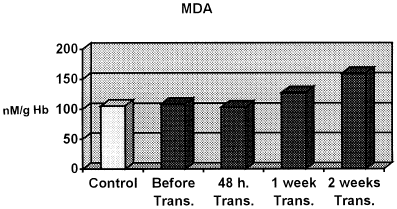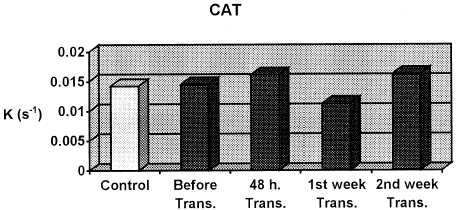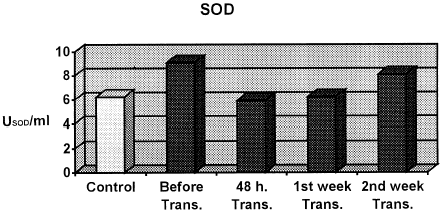Abstract
The aim of this study was to evaluate the antioxidant enzymes, catalase (CAT) and superoxide dismutase (SOD), in renal transplant patients and at the same time to report on the degree of lipid peroxidation observed in these patients. In order to do so we measured erythrocyte malondialdehyde (MDA), a product of lipid peroxidation. These measurements were made at different times: before the transplant, 48 h after the transplant, a week after the transplant and two weeks after the transplant. The values reported were compared with a control group. The results showed that there was a higher MDA level in the transplant group than in the control group one week after the transplant. In addition, two weeks after the transplant, the activities of CAT and SOD were higher in the transplant group than in the control group.
INTRODUCTION
The most important oxygen free radicals are the O2 superoxide radical, the O2 peroxide ion and the OH hydroxyl radical. They are considered important intermediaries in mitochondrial respiratory process in which there is a complete reduction of O2 in water. Several metals, including iron, mercury and copper, are known as catalyzers in the formation of free radicals. Free radicals are highly reactive chemical species, which induce lipid peroxidation in cell membranes, lead to changes in DNA, degrade hormones, inactivate enzymes and even cause cell death.Citation[[1]]
The process of lipid peroxidationCitation[[2]] occurs when polyunsaturated fatty acids (PFAs) undergo oxidative reactions initiated by free radicals. The polyunsaturated fatty acids are contained in the phospholipids that make up the cell membrane although the free radicals may react with other lipid molecules containing polyunsaturated fatty acids. MDA is produced as an intermediate product in the oxidation of polyunsaturated fatty acids and is used as an index for lipid peroxidation.
There are various mechanisms that protect cells from the attacks of free radicals. These include the antioxidant enzymes catalase and superoxide dismutase. Catalase is involved in the destruction of hydrogen peroxide produced during cell metabolism. Superoxide dismutase catalyses the dismutation reaction of superoxide radical into hydrogen and oxygen peroxide.
Oxidative stress affects erythrocytes membranes due to oxygen free radical induced lipid peroxidation. In response to free radical attack and subsequent oxidative stress, erythrocyte MDA concentrations are high and enzyme activities are modified. Several studies of oxidative stress have been performed in hemodialysis and peritoneal dialysis patients.Citation[[3]], Citation[[4]], Citation[[5]], Citation[[6]] We report the study of this process in renal transplant recipients.
MATERIAL AND METHODS
Blood samples obtained from blood donors that made up the control group (20 cases) were donated by the Hematology Unit at Hospital Clínico Universitario of Valladolid. Ten patients who underwent renal transplant were studied. Blood samples were obtained before the transplant, 48 h afterwards, and on 1st and 2nd week after the transplant. The samples were collected in heparinized tubes. Red cells were separated from plasma by centrifugation at 3000 rpm for 5 min. Erythrocyte MDA was determined according to the method of Stock and Dormandy.Citation[[7]] The results were expressed in moles per hemoglobin gram. The activity of catalase was determined by using the method of Aeby.Citation[[8]] The activity of superoxide dismutase was measured following with enzymatic method employing a Randox Kit. The activity was expressed in SOD per milliliter units.
RESULTS
and show the results obtained in this study for each of the different values studied. shows the activities of antioxidant enzymes CAT and SOD, and MDA concentrations ± standard deviation both in patients and in controls. The number of cases studied is shown in brackets. MDA levels were slightly high before the transplant and increase significantly after the first week (). CAT activity was slightly increased 48 h after the transplant and two weeks after the renal transplant (). SOD activity was increased before the transplant, rising significantly again two weeks after the transplant ().
Table 1. Average Values±Standard Deviation of All Determinations Carried Out
DISCUSSION
With regard to malondialdehyde levels, there was a slight increase before the transplant. Forty-eight hours after the operation there was a slight decrease in the levels. It was after the first week that the greatest differences were observed. At this time there was a significant high increase of levels, which persisted two weeks after the transplant.
Various studiesCitation[[4]] on patients undergoing hemodialysis have found an increase of MDA levels. An explanation put forward for the increase of lipid peroxidation as a result of hemodialysis is the bio-incompatibility of the dialyzer membrane. Contact with the membrane may cause bio-incompatible reactions due to some of the membrane components. As a consequence of these reactions there is a secretion of a variety of biologically reactive components, which produces an activation of neutrophils that release large amounts of superoxide radicals.
With regard to the MDA levels 48 h after the transplant, there is not a clear reason to explain the observed decrease. However, a week after the transplant there is a large increase in MDA levels, and this increase is even bigger two weeks after the transplant. A possible reason for this increase is the treatment applied to these patients. Patients underwent a double therapy with cyclosporine and corticoids.
Kumar et al.,Citation[[9]] in a study in laboratory animals, reported that the use of cyclosporine provokes an increase of MDA levels. Whatever the reason, Dasgupta et al.,Citation[[10]] have confirmed that kidney patients who undergo renal transplantation show higher MDA levels than in a control group.
The high MDA levels are indicative of a high level of lipid peroxidation. This in turn may provoke ischemic injury and may be another factor for graft rejection. Thus, a reason to inhibit lipid peroxidationCitation[[11]] is to eliminate this potential factor in graft rejection.Citation[[12]], Citation[[13]] With this in mind, it is important to determine the antioxidant enzymes.
As regards the catalase activity, it is reported to be higher than in the control group before the transplant. There is discrepancy about these results in one aspect: while some authors report a higher activity in patients than in control groups,Citation[[14]] others have reported a normal activity.Citation[[15]], Citation[[16]] These differences in the results may be due to different factors, such as the heterogeneity of the groups studied. Yet, all the authors agree that there is some kind of enzymatic alteration due to an increase of free radicals.
Forty-eight hours after the transplant there was an increase in the values of CAT activity, which indicates an improvement of the antioxidant mechanism shortly after the transplant was done. A week afterwards there was a decrease of the activity, which might be due to the large increase of MDA levels. This situation reverses again two weeks after the transplant, when the levels of CAT activity are higher than in control group. Simic-Ogrizovi et al.Citation[[17]] point out that there is an increase of antioxidant enzymes after the transplant.
Before the transplant, patients undergoing hemodialysis showed higher SOD values than in the control group. This may be due to an increase in the levels of some ions (such as copper) that are present in the dialysis membrane.Citation[[2]] The presence of these ions is toxic due to their induction capacity of highly toxic radical species, producing an increase of SOD activity to eliminate them and avoid any damage to erythrocytes by these species.
Davenport and col.Citation[[12]] point that the SOD levels decrease in patients who have just been transplanted and receive immunosuppressant with cyclosporine, which confirms the results of this study in SOD measurements 48 h after and a week after the transplant. Two weeks after the transplant SOD levels increased again, which involves a strengthening of the defense system of the organism as time goes on after the transplant. This has been confirmed by other authors.Citation[[17]]
REFERENCES
- Halliwell B., Gutteridge J.M.C. Free Radicals in Biology and Medicine. 2nd Ed. Oxford Clarendon Press. 1989; Vol I: 13–15
- Chiu D., Knypers F., Lubin B. Lipid Peroxidation in Human Red Cells. Seminars in Hematology 1982; 26: 257–276
- Del Canto E., Barrero M.J., Martín Mateo M.C. Oxidative Stress in Patients Undergoing Hemodialysis. Kidney International 1997; 4: 52–55
- Hernández Rojas A., Martín Mateo M.C. Superoxide Dismutase and Catalase Activities En Patients Undergoing Hemodialysis and Continuous Ambulatory Peritoneal Dialysis. Renal Failure 1996; 18: 937–946
- Martín Mateo M.C., Del Canto E., Barrero M.J. Oxidative Stress and Enzyme Activity in Ambulatory Renal Patients Undergoing CAPD. Renal Failure 1998; 20: 117–124
- Martín Mateo M.C., Sánchez-Portugal M., Iglesias S., De Paula A., Bustamente J. Oxidative Stress in Chronic Renal Failure. Renal Failure 1999; 21: 155–167
- Stock J., Dormandy T. The Autoxidation on Human Red Cell Lipid Induced by Hydrogen Peroxide. Br. J. Hematology 1971; 20: 95–111
- Aeby H. Catalase Activity In Vitro. Methods in Enzymology 1984; 5: 105–121
- Kumar K.V., Naidu M.U., Shifow A.A., Prayag A., Ratnakar K.S. Melatonin: An Antioxidant Protects Against Cyclosporine-Induced Nephrotoxicity. Transplantation 1999; 67: 1065–1069
- Dasgupta A., Malhotra D., Levy H., Marcadis D., Blackwell W., Johnston D. Decreased Total Antioxidant Capacity but Normal Lipid Hydroperoxide Concentrations in Sera of Critically Ill Patients. Life Sci. 1997; 60: 335–340
- Sorensen V., Nilsson U., Pettersson S., Schersten T., Sjoquist P.O., Svensson L., Jonsson O. Effect of a New Inhibition of Lipid Peroxidation on Kidney Function After Ischemia-Reperfusión. A Study on Rat and Rabbit Kidneys. Acta Physiol. Scand. 1996; 157: 289–297
- Davenport A., Hopton M., Bolton C. Measurement of Malondialdehyde as a Marker of Oxygen Free Radical Production During Renal Allograft Transplantation and the Effect on Early Graph Function. Clin. Transplant 1995; 9: 171–175
- Sherke R.L., Balasubramaniam K.A., John G.T., Jacob C.K., Shastry J.C. Free Radical Injury in Human Renal Allograft Rejection. Indian J. Med. Res. 1994; 100: 70–72
- De Paepe; Malhorta D. Influence of Continuous Ambulatory Peritoneal Dialysis on the Anemias End Stage Renal Disease. Kidney Int. 1983; 23: 744–748
- Balashova T.S., Shastry B. Lipid Peroxidation as a Possible Mechanism of Erythrocyte Damage in Patients with Chronic Renal Failure. Ter. Arckh. 1992; 64: 66–69
- Asoyama K., Chiu D. Antioxidant Enzymes and Lipoperoxide in Blood Uremic Children and Adolescents. Free Radical Biol. Med. 1990; 9: 105–109
- Simic-Ogrizovi S., Smic T., Reljic Z., Markovic S., Blagojevic R., Radivojevic D., Lezaic V., Djukanovic L., Mimic-Oka J. Markers of Oxidative Stress After Renal Transplantation. Transp. Int. 1998; 11: 125–129



